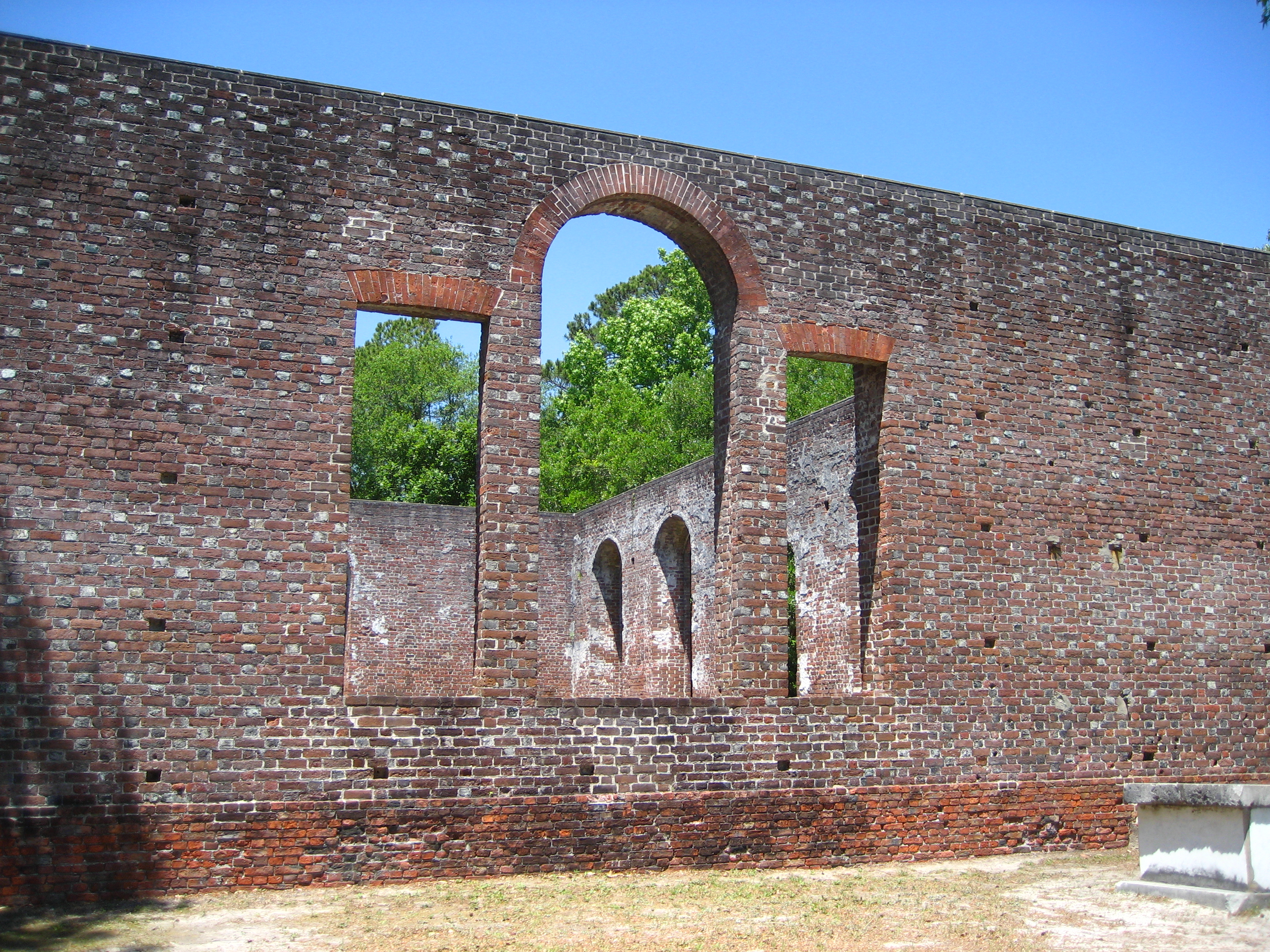- St. Philip's Church Ruins
Infobox_nrhp | name =St. Philip's Church Ruins
nrhp_type =

caption =
location= Smithville Township,North Carolina
lat_degrees = 34
lat_minutes = 2
lat_seconds = 32
lat_direction = N
long_degrees = 77
long_minutes = 56
long_seconds = 55
long_direction = W
locmapin = North Carolina
area =
built =1754
architect= Unknown
architecture= No Style Listed
added =February 26 ,1970
governing_body = State
refnum=70000442cite web|url=http://www.nr.nps.gov/|title=National Register Information System|date=2008-05-10|work=National Register of Historic Places|publisher=National Park Service ] The St. Philip's Church Ruins are the remains of a colonial Anglican church building in Brunswick Town,North Carolina ,United States .cite web| last=| first=| title="Brunswick Town/Fort Anderson" | work=| publisher=North Carolina Office of Archives and History| date=| url=http://www.nchistoricsites.org/brunswic/brunswic.htm| accessdate=2008-05-11] The church is located beside theCape Fear River in theBrunswick Town Historic District , along with Fort Anderson,Russelborough and the nearbyOrton Plantation . Construction of St. Philip's Church lasted 14 years, but took only one day to be destroyed when theBritish Army burned Brunswick Town.cite web| last=Prose| first=Francine| title="A Sojourn On Cape Fear" | work=| publisher="New York Times "| date=1993-03-07| url=http://query.nytimes.com/gst/fullpage.html?res=9F0CE1D91339F934A35750C0A965958260&sec=&spon=&pagewanted=2| accessdate=2008-05-11] Before its demise, the building was considered one of the finest religious structures in theProvince of North Carolina . [Citation |last=Lossing |first=Benson |year=1860 |title=The Pictoral Field-book of the Revolution |publisher=Harper & Brothers |pages=362|] OnFebruary 26 ,1970 , the St. Philip's Church Ruins was added to theNational Register of Historic Places .cite web| last=| first=| title="North Carolina - Brunswick County" | work=| publisher=National Register of Historic Places | date=| url=http://nationalregisterofhistoricplaces.com/nc/Brunswick/state.html| accessdate=2008-05-11]History
In 1741, the St. Philip's
Parish was created in Brunswick Town with James Moir as the firstvicar . Construction of St. Philip's Church began in 1754, but was not completed until 1768. The first minister to lead the new church was John Barnett and colonial governorArthur Dobbs designated St. Philip's as "His Majesty’s Chapel in North Carolina." Barnett was succeeded by J. Cramp and Nicholas Christian. During theAmerican Revolutionary War , the British Army attacked Brunswick Town and burned St. Philip's Church, Russelborough, and most of the homes and businesses. The church walls were the only parts of the structure not to be destroyed. Brunswick Town was deserted and the church remains were relatively untouched for almost a century.cite web| last=| first=| title="History" | work=| publisher=St. Philip’s Episcopal Church | date=| url=http://www.stphilipschurch.org/php/history.php| accessdate=2008-05-11] cite web| last=| first=| title="St. Philip's Anglican Church" | work=| publisher=North Carolina Department of Cultural Resources | date=| url=http://www.carolinarosedesigns.com/brunweb/church.htm| accessdate=2008-05-11]In March 1862,
Confederate Army engineers began to survey the remains of Brunswick Town and St. Philip's Church. The Confederates builtearthworks and trenches in the town, covering the remains of several burnt structures except for the church. The fort was constructed to protect the city of Wilmington 18 miles (29 km) upstream, a vital port during the Civil War. The bastion was named Fort St. Philip, but renamed Fort Anderson in July 1863. [Citation |last=Fonvielle |first=Chris |year=2001 |title=The Wilmington Campaign: Last Departing Rays of Hope |publisher=Stackpole Books |pages=29-30|isbn=0811729915] During the attack on Fort Anderson in February 1865, cannon balls shot from Union ships in the Cape Fear River hit the walls of St. Philip's Church and are still evident today. When the Confederate forces were defeated, Union soldiers desecrated several graves at St. Philip's Church and removed the building'scornerstone . Confederate bodies were placed inside the church. [Citation |last=Fonvielle |first=Chris |year=1999 |title=Fort Anderson: Battle for Wilmington |publisher=De Capo Press |pages=93 |isbn=1882810244]In 1899, the newly formed Cape Fear Chapter of the North Carolina Society of
The Colonial Dames of America visited the St. Philip's Church Ruins to pay homage to Revolutionary War casualties in Brunswick Town. In 1902, the chapter erected a marble plaque inside St. Philip's to commemorate Brunswick Town co-founder, Maurice Moore. Excavations at Brunswick Town began in 1958 and items such as bullets, buttons, and a cannon ball were retrieved from inside the St. Philip's Church ruins. The church is now part of the Brunswick Town State historic site. Visitors may walk through the church and tour the earthworks of nearby Fort Anderson. [Citation |last=South |first=Stanley |year=2005 |title=An Archaeological Evolution |publisher=Springer |pages=108 |isbn=0387234012] [Citation |last=Fonvielle |first=Chris |year=1999 |title=Fort Anderson: Battle for Wilmington |publisher=De Capo Press |pages=93,96 |isbn=1882810244]Architecture
The St. Philip's Church Ruins consists of four brick walls, as well as graves located inside and outside of the church. The bricks used for construction were imported from
England and the walls measure three feet (0.91 m) thick. The building is 76 feet six inches (23.3 m) long, 53 feet three inches (16.2 m) wide, and 24 feet four inches (7.4 m) high. The floor and roof were destroyed in the fire, as well as the three doors and eleven windows that measured fifteen by seven feet (4.6 m x 2.1 m). The church floor was made of wood, except for the aisles which featured one foot (0.3 m) square brick tiles that formed the shape of a cross. The pews were wooden and the Governor's pew was raised above the others. Twelve burial sites are located inside the church and there are several graves remaining outside of the structure that were not desecrated by Union troops. [Citation |last=Haywood |first=Marshall |year=1903 |title=Governor William Tryon, and His Administration in the Province of North Carolina |publisher=E. M. Uzzell |pages=24|] Notable people buried at St. Philip's Church include Arthur Dobbs, Governor Benjamin Smith, and Supreme Court Associate JusticeAlfred Moore .cite web| last=| first=| title="St. Philips Church " | work=| publisher=Historical Marker Database | date=| url=http://www.hmdb.org/Marker.asp?Marker=6467| accessdate=2008-05-11] cite web| last=| first=| title="Arthur Dobbs (1689-1765)" | work=| publisher=North Carolina History Project | date=| url=http://www.northcarolinahistory.org/encyclopedia/14/entry/| accessdate=2008-05-11] cite web| last=| first=| title="Brunswick County North Carolina | work=| publisher=The Political Graveyard | date=| url=http://politicalgraveyard.com/geo/NC/BN.html#0S90N7Z8A| accessdate=2008-05-11] cite web| last=| first=| title="Alfred Moore (1755-1810)" | work=| publisher=North Carolina History Project | date=| url=http://www.northcarolinahistory.org/encyclopedia/146/entry| accessdate=2008-05-11]ee also
*
List of Registered Historic Places in North Carolina References
Wikimedia Foundation. 2010.
